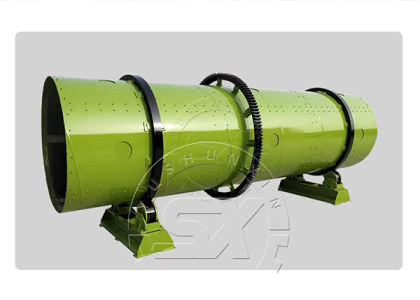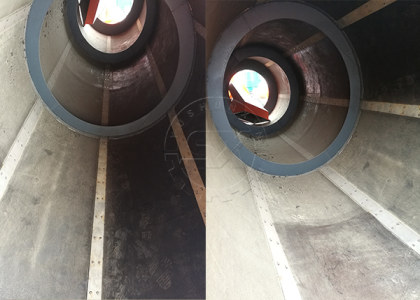Drum Granulator
Drum granulator, also called rotary granulator is an essential fertilizer machine in the compound fertilizer industry.
A lot of manufacturers favor this fertilizer granulation machine. Because it can achieve large-scale production of fertilizers and adopts wet granulation.
Construction of Drum Granulators
The rotary wet granulator consists of a rotating cylinder, which is slightly slanted so as to transport materials to the next procedure. There is a rubber or plastic material inside the drum to prevent sticking and to protect the drum from wear and tear. Another important part is the motor, which can provide the power to rotate the drum. The motor can be electric or hydraulic depending on the size and type of the drum granulator.
Working Principle of Drum Granulators
The main motor drives the belt and pulley, and then the reducer can transmit to the main shaft. The main shaft installed with an open gear meshes with a large gear fixed to the body and works in opposite directions. Material is fed in from the feeding end and goes through the interior of the drum. The structure inside the drum body turns the material into granules, which then flow out through the outlet. Continuous material feeding and the rotation of the granulator make large-scale production possible.
The main granulation method is agglomeration wet granulation. When you add a certain amount of water to the inside of a drum granulator, a chemical reaction will happen in the cylinder. With the machine rotating, the particles move in a circle and then become balls by squeezing and agglomeration.
The drum granulator uses a special rubber plate lining or acid-resistant stainless steel lining, which eliminates traditional scraper devices and achieves automatic scar removal and de-rusting. This machine has the characteristics of a high granulating rate, good appearance quality, corrosion resistance, wear resistance, low energy consumption, long service life, and convenient operation and maintenance.
What Can Influence The Granulating Process Of Rotary Drum Granulator Machine?
The rotary wet granulator consists of a rotating cylinder, which is tilted to transport materials to the following procedure. There is a rubber or plastic material inside the drum to prevent sticking and to protect the drum from wear and tear. Another important part is the motor, which can provide the power to rotate the drum. The motor can be electric or hydraulic depending on the size and type of the drum granulator.
Rotation Speed
The optimal speed of the drum granulator is 35% to 50% of the critical speed. The small drum granulator takes a large value, and the large one takes a small value. You can adjust its speed according to the size of your granulator.
It seems that rotational speeds lead to a high number of contacts due to the accumulation of particles. While higher speeds contribute to the spreading of particles and hence particles get less number of contacts.
Inclination
The angle of the drum body to the discharge end is 2° to 5°. The length-to-diameter ratio, that is L/D, is between 2.0 to 7.0, with a typical value greater than 3.
Filling Coefficient
The inlet and outlet of the drum granulator are equipped with locking rings to prevent material overflow and ensure the filling coefficient of the material inside the drum granulator. The filling coefficient is related to the production capacity, granulation quality, and power of the drum granulator. Generally, it is 25% to 30% of the total volume of the drum, and the height of the outlet blocking ring is determined accordingly (usually 18% to 22% of the drum diameter).
Capacity
The production capacity of the rotary granulator machine is calculated according to the following formula: the inner wall area of the drum granulator required to produce 1 ton of granular compound fertilizer per hour is 3 to 4 square meters. Inclination, together with diameter and length can determine the capacity. For example, if well installed(installation angle between 2-5°), a drum granulator with a diameter of 2m and a length of 8m can produce 8-15t per hour, which would be around 6000t per year.
5 Advantages of a Rotary Type Granulator
- 1
High Capacity: Drum pelletizers are capable of handling large quantities of material. If you need a large-scale production, it is ideal for your business.
- 2
Uniform particle size: Drum granulators produce uniformly sized granules, ensuring consistent quality of the final product. You can get uniform and nice pellets.
- 3
Customizable: You can customize rotating drum granulators in different diameters and lengths as you need, thus you can produce various types of fertilizer granules.
- 4
Low Maintenance: Drum-type granulator machines have no moving parts and they can greatly save your maintenance cost.
- 5
Cost-Effective: Compared to other granulators, the price of rotary drum granulators is low. Due to its high capacity, it is cost-effective and a good choice if you plan to make fertilizer pellets. At the same time, they are energy-efficient and require relatively low amounts of energy to operate, reducing energy costs and making them a more environmentally friendly option.
Drum Granulators VS Pan Granulators
Both drum granulation and pan granulation use the wet granulation method. Pan granulators are ideal for producing small, uniform pellets. What’s more, you can use them in the production of animal feed, fertilizer, and other granulated products (you can also use the pan granulation production line to produce cat litter). Disk granulators are also relatively simple to operate and maintain. While drum granulators are best for producing larger pellets with a wider size distribution.
When choosing between a drum granulator and a disc granulator, many fertilizer manufacturers choose the former type because it provides higher throughput than the disc granulator. The drum granulator also has the advantage of being a closed system. This closed system ensures the granulation process in a closed environment, thereby limiting the dispersion of materials. However, workers should be at the scene to ensure the granulating process works smoothly.
The granulation effect of the rotary drum granulator will directly affect the granulating rate and product quality. It overcomes many disadvantages in the granulation process of the disc granulator, such as ingredient mixing, particle formation rate, particle strength, output, labor intensity, dust in the granulation workshop, and cost. It is excellent granulation equipment for the production of high-concentration compound fertilizers. The entire process of granulating is based on the physical movement of the materials inside the drum.
Reliable Rotary Granulator Machine Manufacturers
With years of experience in the field, MFP company has developed a reputation for providing top-quality rotary granulator machines. We can meet the various needs of our customers.
We have the expertise and resources to deliver a product that meets your specific requirements.
In addition to our top-quality products, we provide exceptional service to our customers as well. We work closely with our clients to understand their unique needs like different customs and installation instructions. Our team of experts is always available to answer any questions and provide technical support whenever you need it.





